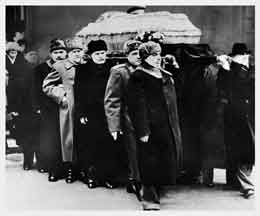1953 Stalin Dies

Stalin's Funeral
On March 5th, 1953 Joseph Stalin died of a cerebral hemorrhage. His death brought to an end one of the most deadly dictatorships of the 20th century. His funeral was held on March 9th in Red Square. Stalin was succeeded by Nikita Khrushchev. The new government eliminated some of the most repressive activities of the Stalin regime, including the execution of Laurentia Beria the head of the Secret Police.
On March 5, 1953, Soviet leader Joseph Stalin died. While several conspiracy theories claim he might have been poisoned or axed, the generally prevailing view is that he died four days after a stroke.
The death of Stalin was announced the day after he died on March 6. For three days, his body lay in state in the House of Unions. Millions throughout the Soviet Union publicly mourned his death. Then, on March 9, his body was moved to Red Square. There, thousands of mourners rushed to get near the coffin of the "Great Leader." Unfortunately, hundreds perished in a stampede.
Stalin's death created a leadership vacuum in the Soviet Union as no successor had been designated. There were three contenders; Lavrenti Beria, the head of the KGB; George Malenkov, the Deputy Head of Ministries and Nikita Khrushchev, the Head of the Moscow Party Administration. Beira was considered the leading contender, but the other two managed to convince Beria's two deputies to turn on him, and he was arrested and charged with treason. Beria had made many enemies over the years and was tried, convicted, and executed.
Malenkov favored opening up the Soviet Union, relaxing some of the controls on individuals, and transitioning away from heavy industry to light manufacturing. He was the intellectual's favorite, and Khrushchev, the head of the Moscow Party Administration, was a favorite of the party. He supported only limited reform.
For a limited period, there was authentic collective leadership. But in September 1953, Khrushchev was elected the First Secretary of the Communist Party of the Soviet Union. This gave him additional powers, and he used them to outmaneuver Malenkov. On February 8, 1955, he was forced to resign as head of the Soviet of Ministers, and thus Khrushchev was now his sole power.
 >
>